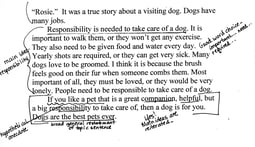Student Writing Samples | Informational Writing
Informational Writing - Grade 3 - Dogs
Read Time 4 mins | Mar 25, 2020 5:14:37 PM | Written by: Toolbox
/Dogs%20Sample%20Image%20copy.jpg?width=220&name=Dogs%20Sample%20Image%20copy.jpg)
(Click image to download sample and feedback)
WOOF! WOOF! Warren, a third grade student, loved to act like a dog. He’d get down on all fours and sniff around the room, bark on command, and even sit and stay (on a good day). As you can imagine, writing was about the last thing Warren wanted to do. In fact, most days he completed very little for his classroom teacher. I was brought in to provide intervention services for this wiggly third grader and to help him to produce writing that had some substance. A large task, but not insurmountable.
What kind of dog are you? What color fur do you have? How about your tail? Is it long or short? What do you like to do? What kinds of things do you need in order to survive? Surprisingly, Warren had very specific answers to all of these questions, as a result of having plenty of first-hand “experience.”
This led me to our writing lesson of the day and the coming week. Warren and I were going to write about dogs. Luckily I knew I had a nonfiction book about dogs that I could put my hands on. We embarked on our writing lesson on the main idea, “appearance.” After engaging Warren in an oral discussion and looking at pictures of dogs we both had a good idea about physical characteristics and variations in dogs. I worked with Warren on this paragraph and, amazingly, he wrote about ten sentences, more than he had written in the previous month.
Warren went on to become a somewhat fluent writer over the course of the next few months. We just had to unlock his potential and develop some very specific skills to rely on. The sample is a good illustration of the applied skills that I work on with my students.
The introduction introduces the main ideas that are each broad enough to cover a number of interesting details, each of which is distinct from the others. The author uses many specific details and examples, an amazing fact, and an anecdote – all tools for showing rather than telling. There is also a bit of linking a fact to the idea of elaborating on that by explaining why that fact is important to the main idea. (Ex. Lonely people can get a dog – they’d have a cuddly friend, they go through an entrance blocked by fire to lead people out.) There’s also good word choice throughout this piece.
What worked:
- strong organizational strategy
- effective combination of broad yet distinct main ideas
- numerous specific examples along with why these facts are important to the main idea
- good word choice
- use of a hypothetical anecdote to bring the reader in touch, hypothetically, with the topic
- creatively restates main ideas in the conclusion
Empowering Writers has a proven methodology, specific strategies, and lessons to teach each of these skills.
Recommended Resources



